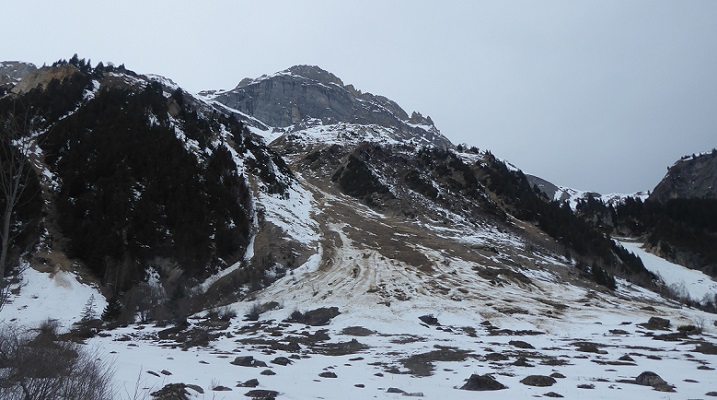
I have visited the Vanoise National Park, several times over the years, including last summer during the drought that brought Autumn early to the mountains (see here). I was back there last week at the end of a skiing holiday which finished early due to illness and bad weather.
Skiing back down into Pralognan from the Refuge de Peclet Polset I was struck by the extent of the apparently bare ground created by avalanches on the western side of the valley just north of Petit Mont Blanc.
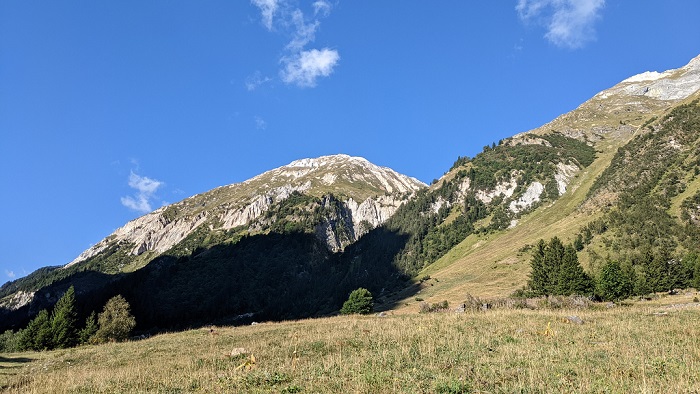
The same slope last summer was free of trees and clearly regularly swept by avalanches but the parched ground vegetation appeared intact. While slopes denuded of vegetation by avalanches or landslips can recover quite quickly, it appears that it has been the recent avalanche activity this winter that has been responsible for creating areas of bare ground. Those areas, however, are not quite as extensive as might appear from a distance:
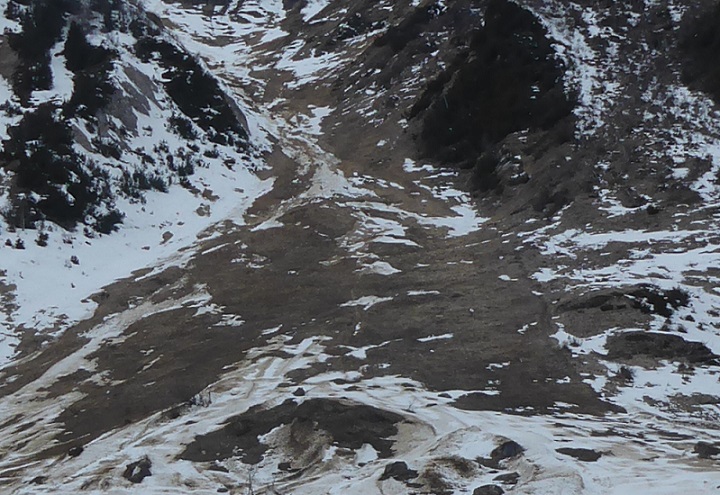
A close up of the main avalanche fall line shows that significant areas of ground vegetation has survived, while more may be concealed under the soil brought down by the avalanche and water subsequently. Still, although some vegetation is still clinging on, the dirty snow tells a tale – the plants and trees on this slope are now subject to serious erosive forces.
I have been down the nearby path up Petit Mont Blanc twice, the first 25 years ago with my daughter in a back pack, but when I passed on the GR5 last summer it had been destroyed.
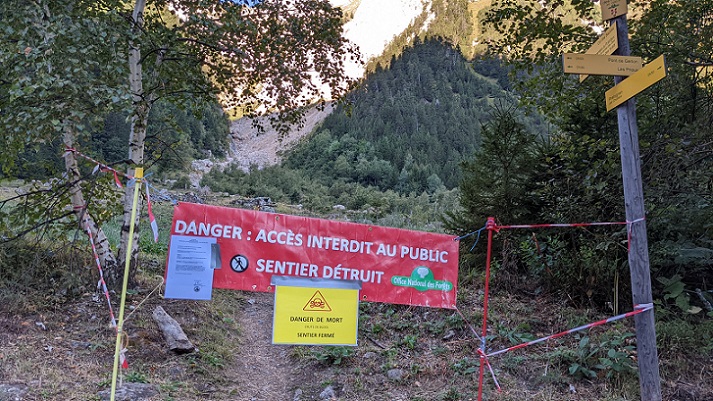
That was not such a surprise, as the path passes through a steep gorge and because of that I confess to having paid more attention to the signs and the procedures used to close paths than to what had caused its destruction.
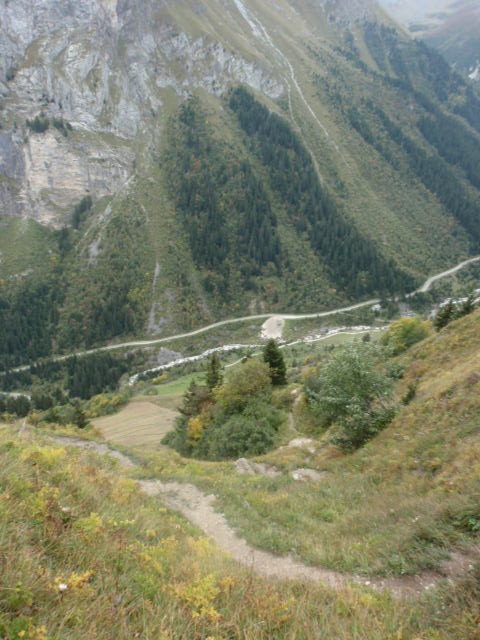
Back in 2010 the avalanche lines through the forest on other side of the valley were obvious. But what is also striking from this photo is how those avalanche lines were covered with smaller trees and the apparently healthy state of the vegetation by the path.
Green alder is a small tree that thrives where avalanches cut through alpine forests, as it bends under the weight of snow. The presence of other trees, however, suggests that though regular, avalanches were not that frequent and the interval between them gave time for the ground vegetation to recover.
I have three photos looking up the gorge taken by the Petit Mont Blanc path which help illustrate what has been happening.
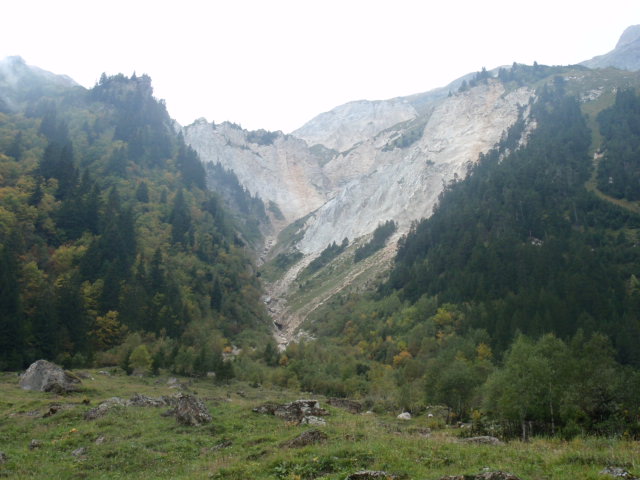
Note the densely wooded areas on either side of the stream and the two small blocks of conifers growing on the steep slope below the slabby cliff in the centre of the photo.
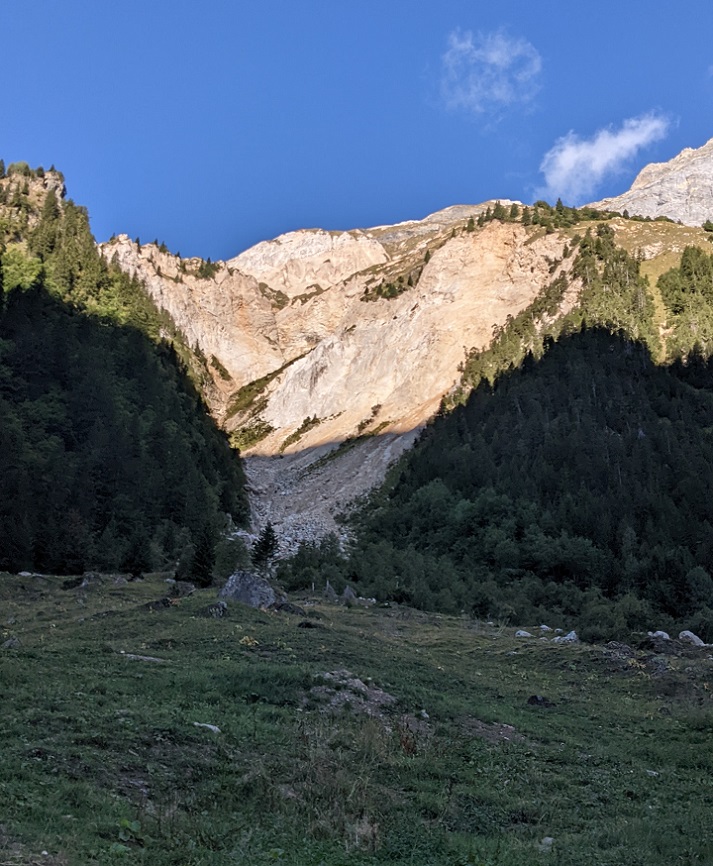
Thirteen years later, the two elongated blocks of conifers below the slabby cliffs had been considerably reduced in extent while the vegetation below them had completely disappeared and been replaced by rock rubble.
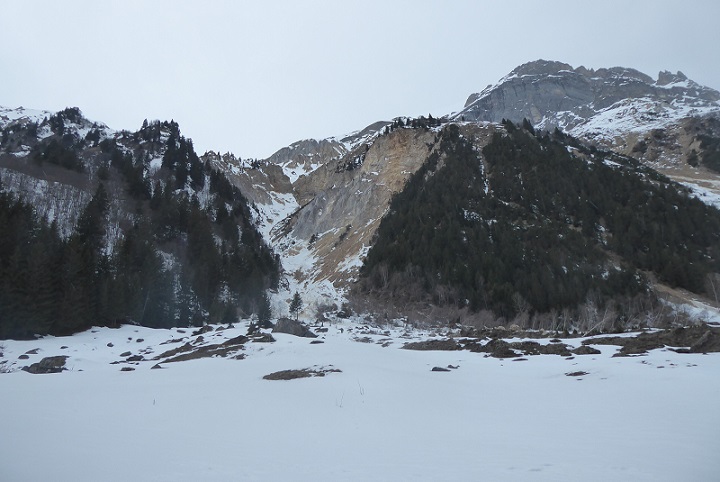
Six months later the two elongated blocks of conifers below the slabby cliffs appear to be on their last legs while an avalanche or avalanches has swept through the block of deciduous trees knocking many over. In addition it appears the slopes to the left of the gorge may be less tree covered than they were 13 years ago.
Discussion
After I published this post I was sent this fantastic photo from Keith Miller showing the slopes in question from the other side of the valley in 2017:
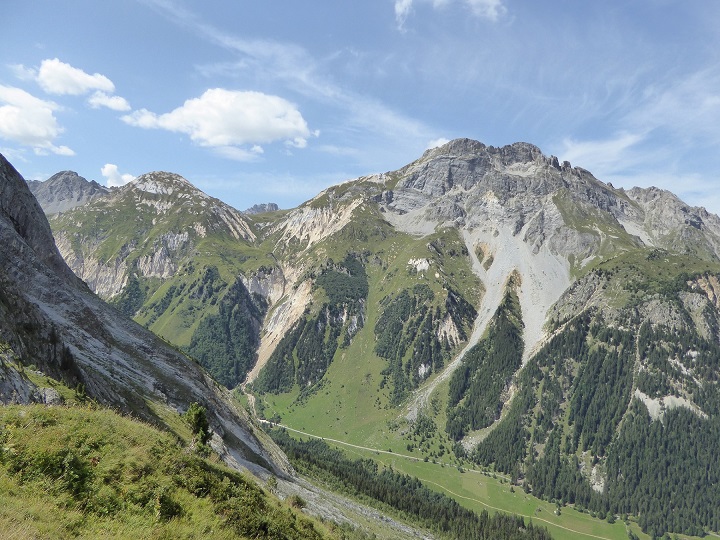
Erosion of mountains is a natural process without which soils, which provide the basis for most terrestrial life including our own, would never have developed. It is not in itself a bad thing or an indication of crisis.
What my photos suggest, however, is that in this particular area of the Alps those erosive processes are now taking place quicker than before as a result of avalanches which are also serving to reverse the colonisation of slopes by trees. That this is not just a specific issue affecting the steep and unstable gorge is indicated by the surrounding slopes which have also been swept by avalanches.
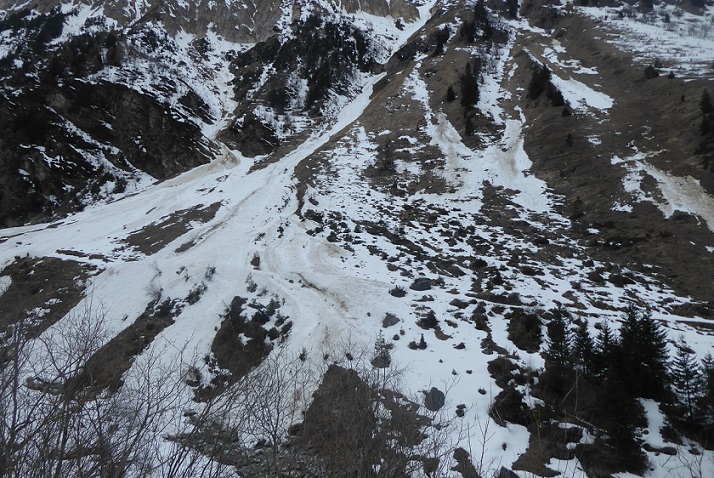
What appears to be happening is that on these slopes there have been more avalanches and these have been steadily denuding the vegetation cover.
One possible explanation is that tree cover, which plays a key role in reducing erosive pressure on slopes, whether from water or snow, has been reducing as a result of grazing pressure and that has helped can create a vicious erosive circle as is happening in many places in Scotland’s National Parks (see here for example). While much of the area in and around the Vanoise National Park is used to graze livestock in the summer months, however, as far as I am aware these slopes are not subject to such pressures and the number of deer and chamois are far better controlled through hunting than they are in Scotland. So, although it is possible that grazing has helped thin the tree cover, for example on the steep ground to the left of the gorge, this does not appear the primary cause of the increased avalanche activity.
A significant amount of research now being undertaken in Europe and North America about the impact that climate change will have on avalanche activity, with some models predicting more and others fewer avalanches! That should not be a surprise because what triggers avalanches depends on many factors including the volume of snow, the composition of the snow pack, air temperature etc etc. As a consequence there are likely to be more avalanches in some places and fewer in others. Unfortunately, I have been unable to find any research which specifically relates to avalanche activity in the Vanoise so will risk my own explanation for what I observed.
To put it simply in the past snow generally accumulated in the Alps during the winter months and then melted during the spring. (In Scotland too there was a far clearer demarcation between the seasons). While there were many avalanches during the winter these tended to be “dry” and could move at considerable speed, even on occasion becoming airborne, and over considerable distances. Typically such avalanches only affect part of the snow pack, a consequence of different layers within the snow and the propensity of these to shear, and are full depth. Such avalanches might snap trees protruding above the basal layers of the snow but not the vegetation beneath.
Winters, however, as we once knew them are now disappearing as a result of climate change. Snow no longer accumulates in the Alps through the winter but, like in Scotland, is subject to warmer and colder periods and is far less regular. Gone are the days of deep snow lying on the ground for months. Before I arrived in the Vanoise there had been no significant new snow since January (we were lucky enough to have 50cm the day after we arrived).
On top of this, with higher background temperatures, sunshine in the Alps is having a greater impact on the snow pack (the slopes in the photos face south east). The result, as explained by some of the research, is an increase in the number wet snow avalanches which, instead of sheering the snow pack, sheer at ground level.
Such avalanches have a considerable destructive impact on the vegetation below. Moreover, instead of sweeping slopes occasionally, the new cycle where snow is deposited and then melts several times a year, means that the same slope can avalanche several times in a year. As they remove the vegetation, the propensity for further avalanches increases and the soil below becomes increasingly vulnerable to erosion.
All this means that the Alpine countries, like Scotland, will need to pay far more attention in future not just to avalanches but to the impact of landslips (see here). That what I witnessed last week is not just a site specific issue is also demonstrated by photos I took last summer of the impact of avalanches ten miles to the south, on the far side of the Col de Chaviere:

Warmer winters and drought in summer is creating another vicious circle: as trees die from lack of water in summer, there will be even less to hold back the wet snow avalanches in winter.
While some research is taking place in Europe on these interactions between climate change and the natural environment – particularly in Switzerland – in Scotland our Government and National Parks still appear to have their heads in the sand. Pious policy statements are completely useless without action. For that I would suggest that Government Ministers, Board Members and senior staff need to start getting out more and try to understand what is happening on the ground.
